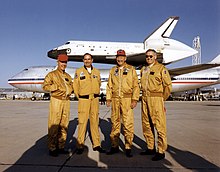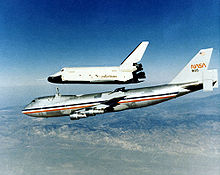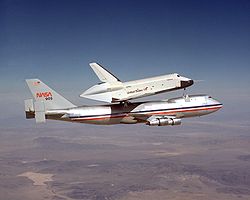Approach and Landing Tests
The Approach and Landing Tests were a series of sixteen
Background
The Space Shuttle program originated in the late 1960s as an attempt to reduce the cost of spaceflight by introducing a
Test program
Upon the orbiter's entry into service,
Crews
The program lasted from February until October 1977, with a pair of two-man crews assigned to the orbiter:
Crew 1
| Position | Astronaut | |
|---|---|---|
| Commander | Fred W. Haise, Jr. | |
| Pilot | C. Gordon Fullerton | |
Haise had previously flown as the Lunar Module pilot of Apollo 13, and was named as the commander of the original STS-2 mission.[note 1] Fullerton later flew as the pilot of STS-3 and commanded STS-51-F.
Crew 2
| Position | Astronaut | |
|---|---|---|
| Commander | Joe H. Engle
| |
| Pilot | Richard H. Truly | |
This crew later flew on STS-2. Engle was originally a USAF pilot on the X-15, and had already gained Astronaut wings by the time he joined NASA. He flew his second Shuttle mission on STS-51-I.[note 2] Truly flew his second Shuttle mission as commander of STS-8.
Shuttle carrier aircraft

In addition to the two assigned Shuttle crews, who would alternate crewing the orbiter, a flight crew was attached to the Boeing 747 Shuttle Carrier Aircraft (SCA) for the entire program - this consisted of a captain and co-pilot, plus a pair of flight engineers:
| Position | Crew member |
|---|---|
| Captain | Fitzhugh L. Fulton, Jr. |
| Co-pilot | Thomas C. McMurtry |
| Flight engineer | Louis E. Guidry, Jr. |
| Flight engineer | Victor W. Horton |
| Flight engineer | Vincent A. Alvarez |
| Flight engineer | William R. Young |
ALT
The ALT program was divided into three distinct phases.[4] The first phase was designated as the "taxi-test" phase, which involved the SCA and orbiter in a mated formation conducting taxi tests at Edwards Air Force Base to verify the taxiing characteristics of the aircraft while carrying the orbiter. These tests did not involve the orbiter in any way beyond it being mated to the aircraft, so consequently it remained powered down and uncrewed. A total of three taxi-tests were performed on February 15, 1977. Following this, the program moved into its next phase.
Captive flights
The captive flight phase of ALT saw the SCA/orbiter combination in flight as a test of the SCA's flying characteristics while mated to the orbiter, and as an initial test of the orbiter systems in flight. This was subdivided into two phases:
Captive – inert
There were a total of five captive-inert flights designed to test the flight and handling characteristics of the aircraft while it was mated to the orbiter. As with the taxi tests, this did not involve the orbiter beyond it being mated to the SCA, so it remained unpowered and uncrewed.
Captive – active
The captive-active flights were intended to determine the optimum profile required for Enterprise to separate from the SCA during the orbiter's free-flights. These were also intended to refine and test the orbiter crew procedures and to ensure the operational readiness of the orbiter's systems. For these three flights, although Enterprise remained mated to the SCA, it was powered and crewed.
Free-flight

The final phase of flight testing involved free-flights. These saw Enterprise mated to the SCA and carried to a launch altitude, before being released to glide to a landing on the runways at Edwards AFB. The intention of these flights was to test the flight characteristics of the orbiter itself, on a typical approach and landing profile from orbit.[5][6][7]
For the approach and landing tests, a nose strut longer than those employed in later ferry flights increased the shuttle's
There were a total of five free-flights between August and October; the first three saw Enterprise remain fitted with its
After flying missions on Columbia (STS-2) and Discovery (STS-51-I), Engle reported that the flight and handling characteristics of the operational orbiters were similar to those of Enterprise, except that he had to fly a steeper profile with the prototype, as it was much lighter than the operational spacecraft.[13]
Ferry flights
Following the free-flight tests, Enterprise was prepared for ferry flight tests, which were intended to ensure that the SCA/orbiter configuration was viable for flights of the duration between landing and launch sites.[14]
List of ALT flights



| Mission | Test flight[10] | Date | Speed | Altitude | Shuttle Crew[15] | SCA Crew[15] | Duration | Comment | |
|---|---|---|---|---|---|---|---|---|---|
| Full flight | Shuttle flight | ||||||||
| ALT-1 | Taxi test #1 | February 15, 1977 | 89 mph (143 km/h) | taxi | none | Fulton, McMurtry, Horton, Guidry |
taxi | Concrete runway, tailcone on | |
| ALT-2 | Taxi test #2 | 140 mph (225 km/h) | |||||||
| ALT-3 | Taxi test #3 | 157 mph (253 km/h) | |||||||
| ALT-4 | Captive-inert flight #1 | February 18, 1977 | 287 mph (462 km/h) | 16,000 ft 4,877 m |
2 h 5 min | N/A | Tailcone on, landed with 747 | ||
| ALT-5 | Captive-inert flight #2 | February 22, 1977 | 328 mph (528 km/h) | 22,600 ft 6,888 m |
3 h 13 min | ||||
| ALT-6 | Captive-inert flight #3 | February 25, 1977 | 425 mph (684 km/h) | 26,600 ft 8,108 m |
2 h 28 min | ||||
| ALT-7 | Captive-inert flight #4 | February 28, 1977 | 425 mph (684 km/h) | 28,565 ft 8,707 m |
2 h 11 min | ||||
| ALT-8 | Captive-inert flight #5 | March 2, 1977 | 474 mph (763 km/h) | 30,000 ft 9,144 m |
1 h 39 min | ||||
ALT-9 |
Captive-active flight #1A | June 18, 1977 | 208 mph (335 km/h) | 14,970 ft 4,563 m |
Fullerton
|
55 min 46 s | |||
ALT-10 |
Captive-active flight #1 | June 28, 1977 | 310 mph (499 km/h) | 22,030 ft 6,715 m |
Truly
|
Fulton, McMurtry, Guidry, Young |
62 min 0 s | ||
ALT-11 |
Captive-active flight #3 | July 26, 1977 | 311 mph (501 km/h) | 30,292 ft 9,233 m |
Fullerton
|
Fulton, McMurtry, Horton, Alvarez |
59 min 53 s | ||
ALT-12 |
Free flight #1 | August 12, 1977 | 310 mph (499 km/h) | 24,100 ft 7,346 m |
Fullerton
|
Fulton, McMurtry, Horton, Guidry |
53 min 51 s | 5 min 21 s | Tailcone on, lakebed landing |
ALT-13 |
Free flight #2 | September 13, 1977 | 310 mph (499 km/h) | 26,000 ft 7,925 m |
Truly
|
54 min 55s | 5 min 28 s | ||
ALT-14 |
Free flight #3 | September 23, 1977 | 290 mph (467 km/h) | 24,700 ft 7,529 m |
Fullerton
|
51 min 12 s | 5 min 34 s | ||
ALT-15 |
Free flight #4 | October 12, 1977 | 278 mph (447 km/h) | 22,400 ft 6,828 m |
Truly
|
67 min 48 s | 2 min 34 s | Tailcone off, lakebed landing | |
ALT-16 |
Free flight #5 | October 26, 1977 | 283 mph (455 km/h) | 19,000 ft 5,791 m |
Fullerton
|
54 min 42 s | 2 min 1 s | Tailcone off, runway landing | |
After ALT

Following the end of the flight test program, Enterprise was taken for testing with the
Video gallery
-
Space Shuttle Enterprise 747 takeoff
-
Space Shuttle Enterprise 747 separation
-
Space Shuttle Enterprise landing
Notes
- Jack Lousma as the pilot, which was scheduled for launch in July 1979, and was to carry the Teleoperator Retrieval System intended to boost the Skylab space station into a higher orbit. Due to the delays in getting the system operational, this mission was scrubbed, and Haise left NASA in June 1979.[3]
- ^ Engle had been scheduled to fly as Lunar Module Pilot of Apollo 17, but was bumped from the flight in favor of Harrison Schmitt; Schmitt, a trained geologist, had been scheduled to fly on Apollo 18, but this mission was cancelled due to budget cuts in September 1970. As a result of pressure from the scientific community to have a trained scientist go to the Moon, Engle was removed from the crew of Apollo 17 to be replaced by Schmitt
References
- ^ a b "Real life 'Enterprise' ready for space". Eugene Register-Guard. Associated Press. September 18, 1976. p. 3A.
- ^ "Space shuttle rocket plane to fly soon". Sarasota Herald-Tribune. UPI. September 12, 1976. p. 11A.
- ^ Carney, Emily (May 14, 2017). "The Last Hurrah: Skylab's 1978-1979 Unmanned Mission". National Space Society. Retrieved March 9, 2021.
- ^ Space Shuttle Approach and Landing Tests Fact Sheet Archived 2009-09-17 at the Wayback Machine From "Space Shuttle Chronology"; Accessed 11/03/08
- ^ "Space flight milestone to be reached in July". Sarasota Herald-Tribune. (Washington Post / L.A. Times). April 11, 1977. p. 13A.
- ^ "Shuttle's maiden solo flight Friday". Beaver County Times. UPI. August 11, 1977. p. A2.
- ^ "Space Shuttle solo is soaring success". Milwaukee Sentinel. (Los Angeles Times). August 13, 1977. p. 3, part 1.
- ^ Approach and Landing Test Evaluation Team (February 1978). Space Shuttle Orbiter Approach and Landing Test: Final Evaluation Report (PDF). Houston: National Aeronautics and Space Administration Lyndon B. Johnson Space Center. Retrieved February 19, 2021.
- ^ Wilford, John Noble (August 13, 1977). "Space Shuttle Glides to a Landing, Passing Its First Solo Flight Test". The New York Times. Retrieved February 21, 2021.
- ^ a b NASA – Dryden Flight Research Center (1977). "Shuttle Enterprise Free Flight". NASA. Archived from the original on March 7, 2013. Retrieved November 28, 2007.
- ^ "Test bumpy, but shuttle lands safely". Free Lance-Star. Fredericksburg, Virginia. Associated Press. October 27, 1977. p. 15.
- ^ "Space shuttle landing rough". Lodi News-Sentinel. UPI. October 27, 1977. p. 22.
- ^ "Joe H. Engle", NASA Johnson Space Center Oral History Project, June 3, 2004.
- ^ Astronautix.com Archived 2010-01-22 at the Wayback Machine Accessed 11/03/08
- ^ a b "Space Shuttle Orbiter Approach and Landing Test Final Evaluation Report" (PDF). NASA Technical Reports Server. NASA. February 1978. Retrieved April 12, 2024.





